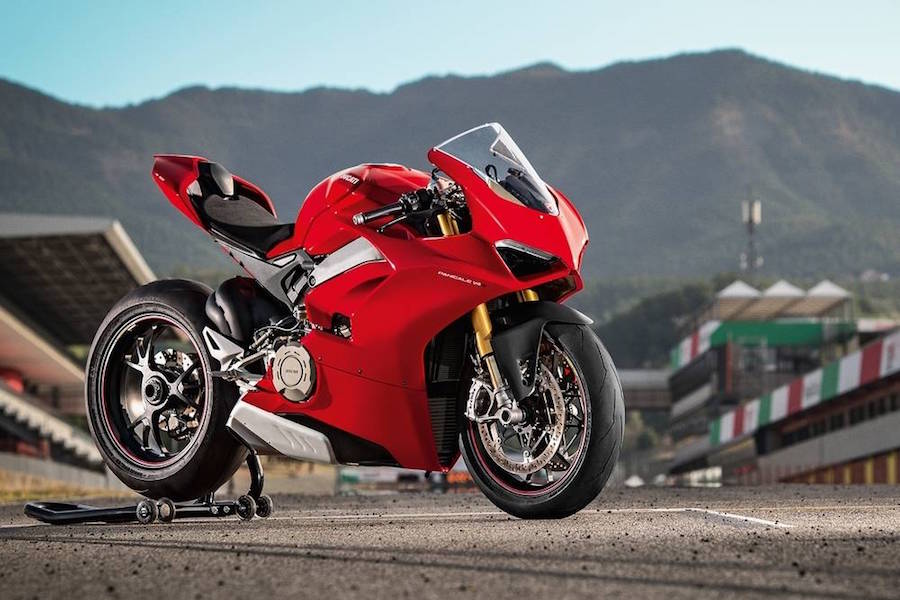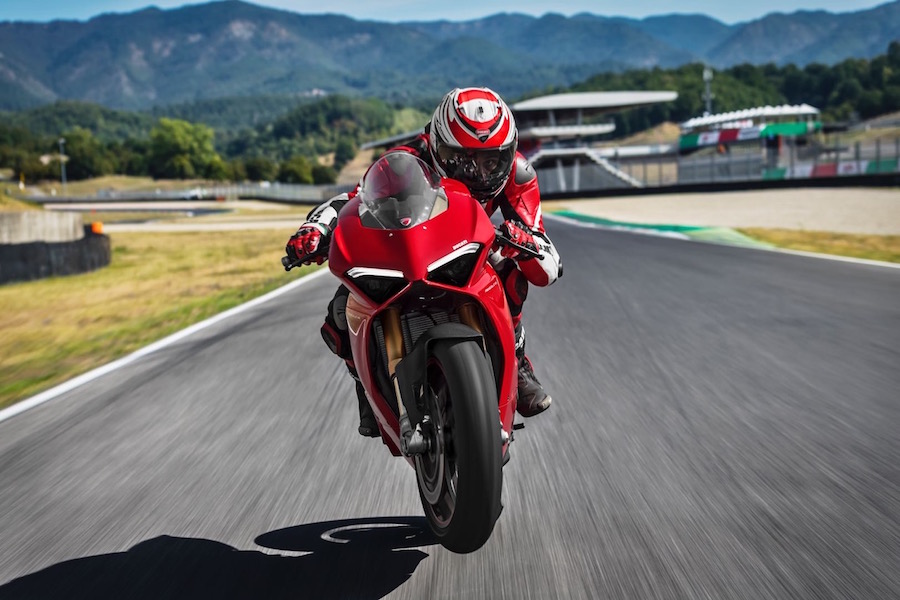The Panigale V4 isn’t Ducati’s first street-legal V4 motorcycle, that honour belongs to the Desmosedici RR, based on Ducati’s Desmosedici MotoGP bike. The RR was powered by a 989cc V4 engine.
The 90-degree V4 engine fitted to the 2018 Panigale V4 produces a claimed 157.5kW (214hp) @ 13,000 rpm, and 124Nm @ 10,000 rpm. That’s 7kW more than the 1299 Panigale it replaces. Ducati says it is the fastest, most powerful production bike that the world has ever seen.

Three versions of the Panigale V4 will be available. The standard model is fitted with a fully adjustable 43mm Showa Big Piston Fork (BPF), Sachs monoshock and Sachs steering damper. The Panigale S has an electronically controlled Öhlins NIX-30 fork and Öhlins TTX36 rear shock, with Öhlins Smart EC2.0 looking after the electronics. Also fitted is an Öhlins steering damper. The Panigale V4 Speciale also gets the Öhlins kit, and features a “Speciale” colour scheme, a host of carbon fibre goodies and a Race Kit which includes a full titanium Akrapovič exhaust system.
The 1103cc V4 Desmosedici Stradale engine powering the Panigale, Panigale S and Panigale Speciale is not eligible for WSBK homologation where four-cylinder machines are capped at 1000cc. Ducati is expected to release an R version of the V4 next year with a 1000cc engine capacity.
Ducati’s new Front Fame is lighter than the current Panigale chassis; however, the claimed kerb weight of the standard Panigale V4 is 198kg, compared to 190.5kg for the 1299 Panigale.
The V4 Desmosedici Stradale engine is banked 42 degrees rearward like its MotoGP counterpart. It also features a MotoGP-style counter-rotating crankshaft to improve handling, with the gyroscopic effect and inertial forces of the engine counteracting those of the wheels rotating in the opposite direction.
Twin Pulse is what Ducati calls the firing sequence of its new V4 engine. The two left-hand cylinders fire first in closer order, followed by the two right-hand cylinders. The crank position of the firing order is Left 0° and 90°, right 290° and 380°.
Service intervals for the V4 Desmosedici Stradale engine are 12,000km, and valve services every 24,000 km.
The new Panigale V4 features a new Brembo Stylema calliper, the latest evolution of the iconic M50. Each calliper is 70 grams lighter.
If you like acronyms, you will love the new Panigale V4. It has: ABS Cornering Bosch EVO, Ducati Traction Control EVO (DTC EVO), Ducati Slide Control (DSC), Ducati Wheelie Control EVO (DWC EVO), Ducati Power Launch (DPL), Ducati Quick Shift up/down EVO (DQS EVO), Engine Brake Control EVO (EBC EVO), and Ducati Electronic Suspension EVO (DES EVO).

Three Riding Modes are available on the Panigale V4.
Race: Delivers 157.5kW (214hp) with direct throttle response and minimal intervention of electronics. On the S and Speciale model, the electronic Öhlins suspension switches to a high-performance hard set-up for track use.
Sport: Delivers 157.5kW (214hp) with a sporty throttle response and slightly more intervention of electronics. On the S and Speciale model a sports-oriented suspension setting for the Öhlins electronic suspension.
Street: Delivers 157.5kW (214hp) with progressive ride-by-wire throttle response. The highest level of intervention by the electronics, and on the S and Speciale models a soft suspension set-up to absorb bumps in the road.
Look out for AMCN’s regular updates from the Circuit Ricardo Tormo once we get our hands on the bike.












